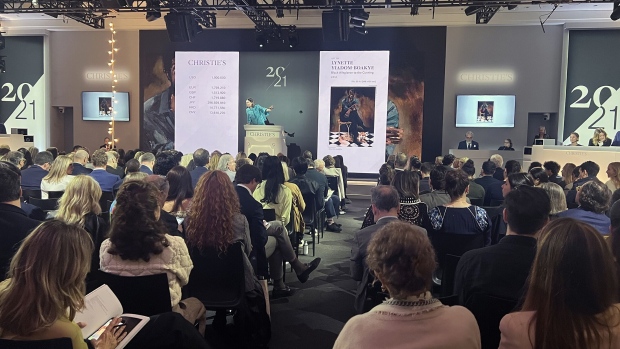
(Bloomberg) — Expectations were low ahead of the bellwether May auctions that took place this week in New York. The overall anticipated sales amounts were down significantly from the year before (and a small fraction of the year before that). In addition to there being no major collections on the block, days before the auctions began, Christie’s was hit by a cyberattack that resulted in its website going offline, leading people to question whether the sales themselves would happen at all.
“Everyone is eager to write the story that the market is down and subdued,” says Charles Stewart, the chief executive officer of Sotheby’s. “And obviously there’s a lot of uncertainty in the world, and the market is more selective, but I think this week is a huge validation for the overall health and strength of the art market.”
Before the sales began, Sotheby’s estimated that it would sell between $549 million and $784 million; its total of $633.4 million landed safely within estimates. (Estimates don’t include auction house fees which can range from roughly 14% to about 26%, known as premiums, although totals do.)
Christie’s also appeared on track to land within its presale estimates of $578 million to $846 million: As of Friday morning, its running total came to $527.9 million, and its remaining day sales were expected to add more than $100 million to its final numbers. Phillips missed the mark (albeit barely), selling $110 million worth of art after estimating that its totals would fall between $113 million and $163.5 million.
“I’m not going to say there’s no room for improvement, but we came out of this very happy,” says Jean-Paul Engelen, the president of the Americas and worldwide co-head of modern & contemporary art at Phillips.
In total, the three auction houses sold a collective $1.3 billion (and counting) worth of art.
Crumbling Market Peak
The very peak of the market—works priced over $20 million or so—seemed to suffer the most. During the May auctions last year, five artworks sold above $40 million. This year, there was only one–a painting by Jean-Michel Basquiat that sold at Phillips on Tuesday night for $46.5 million, eking past its low estimate of $40 million and nowhere near its high estimate of $60 million.
“We weren’t the highest painting of the week with $85 million,” Engelen says, referring to years past, “but suddenly we are with $46 million? That’s the surprising thing.”
Many other ultra-high end works fared similarly—or worse.
A painting by Richard Diebenkorn estimated between $18 million and $25 million failed to find a buyer at Sotheby’s. And at Christie’s, a painting by Brice Marden, which was set to be one of the sale’s most expensive—the estimate was $30 million to $50 million—was withdrawn at the last minute in response to what the auction house indicated was a lack of demand.
“There were some withdrawals,” said Christie’s CEO Guillaume Cerutti, speaking at a press conference after the auction on Tuesday night. “But they were for business, none of them was linked to the [cyberattack] incident.”
The top 10 lots reinforce perceptions of a diminished market. This year, they amounted to around $312 million, about a 22% drop from last year’s total of $403 million. Both pale in comparison to May 2022’s top 10’s $760 million.
Stewart, though, pushes back on the notion that the peak of the market has crumbled. “I honestly think that the things that come at those super-high levels aren’t so driven by people picking a market spot as it is other factors,” he says. “These tend to be driven by collections needing to be sold for whatever reason—it might be an estate situation, it might be whatever family dynamic is leading them to consider to sell an absolute masterpiece.”
But, he continues, “I don’t think there are five pieces that were ready to come, where people were saying, ‘It’s not quite the market moment.’ ”
Engelen has a slightly different takeaway. “If you talk about the general market, if sellers are realistic, there are absolutely buyers out there,” he says. “If they are greedy, then there are no sales.”
The top 10 works of the week are below.
$22.6 million for Joan Mitchell’s Noon from circa 1969
Sold at Sotheby’s
$23 million for Lucio Fontana’s Concetto Spaziale, La Fine di Dio from 1964
Sold at Sotheby’s
$27.7 million for Francis Bacon’s Portrait of George Dyer Crouching from 1966
Sold at Sotheby’s
$28.5 million for Leonora Carrington’s Les Distractions de Dagobert from 1945
Sold at Sotheby’s
$28.6 million for David Hockney’s A Lawn Being Sprinkled from 1967
Sold at Christie’s
$32 million for Jean-Michel Basquiat’s The Italian Version of Popeye has no Pork in his Diet from 1982
Sold at Christie’s
$33.2 million for Vincent Van Gogh’s Coin de Jardin Avec Papillons from 1887
Sold at Christie’s
$34.8 million for Claude Monet’s Meules à Giverny from 1893
Sold at Sotheby’s
$35.5 million for Andy Warhol’s Flowers from 1964
Sold at Christie’s
$46.5 million for Jean-Michel Basquiat’s Untitled (ELMAR) from 1982
Sold at Phillips
©2024 Bloomberg L.P.







